Find backfield space
The most obvious Scottish weakness to target is their defensive backfield. Scotland have been caught out multiple times in recent months by clever attacking kicks that expose a tendency for lax backfield coverage.
At last year’s World Cup, both South Africa and Ireland scored kick tries against Scotland. This year, French wing Louis Bielle-Biarrey caught them out with a chip and chase. Last weekend, Italy kicked their way to two tries in one match.
Fool me once . . .
For Louis Lynagh’s try on Saturday, during Italian phase play, Scotland’s backfield was completely empty. Of the usual backfield defenders, the outhalf, scrumhalf and left wing were too far away from the ball on the opposite flank, while the fullback and the right wing were in the defensive line – no one was home.
Finn Russell misses last-gasp conversion as England hold on to end Scotland run
Misfiring scrum puts serious pressure on Ireland to dig out result against Wales
Simon Easterby hails Ireland’s composure and patience in fightback win over Wales
Wales 18 Ireland 27 FT as it happened: Ireland come back in second half and win the Triple Crown
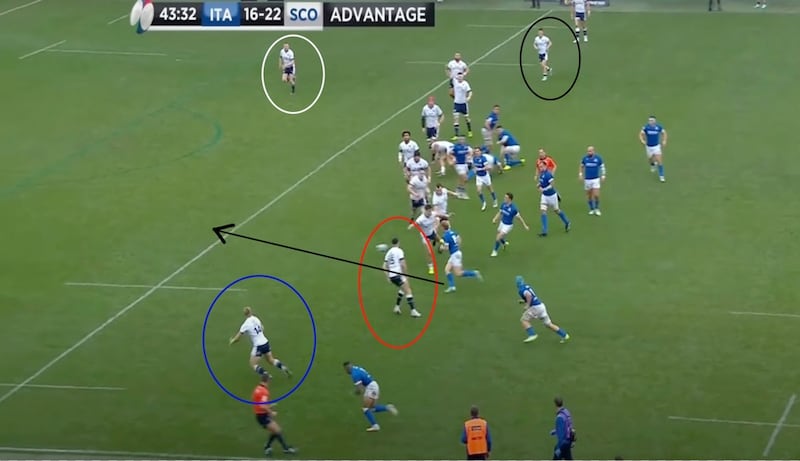
There appears to have been no communication, nor did any of the usual backfield defenders take ownership of the situation.
For the first Italy try, scored by Ignacio Brex, communication was also an issue. At a lineout in the 22, prop Pierre Schoeman tells wing Kyle Steyn to come up from the backfield to stand in the set piece.
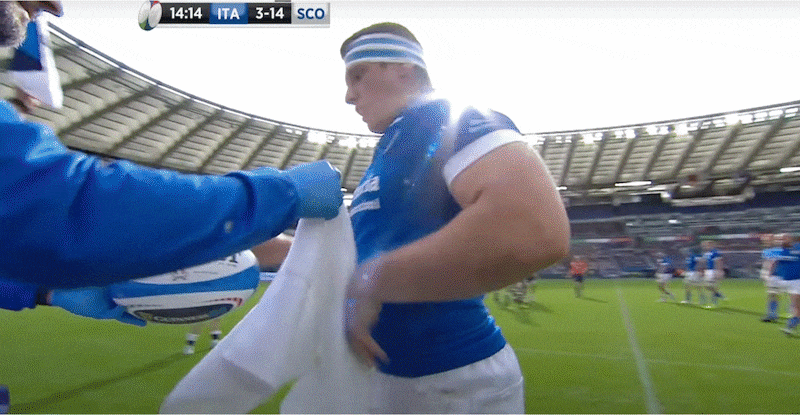
This is to match lineout numbers, since Italy have also positioned a winger at the front. By mimicking that move, Scotland can leave a forward in the backline to avoid a size mismatch, given Italy have done the same.
However, no one then fills in the backfield space previously occupied by Steyn. The speed with which Italy kicked in behind, and subsequently scored, suggests this was something they had identified pre-match.
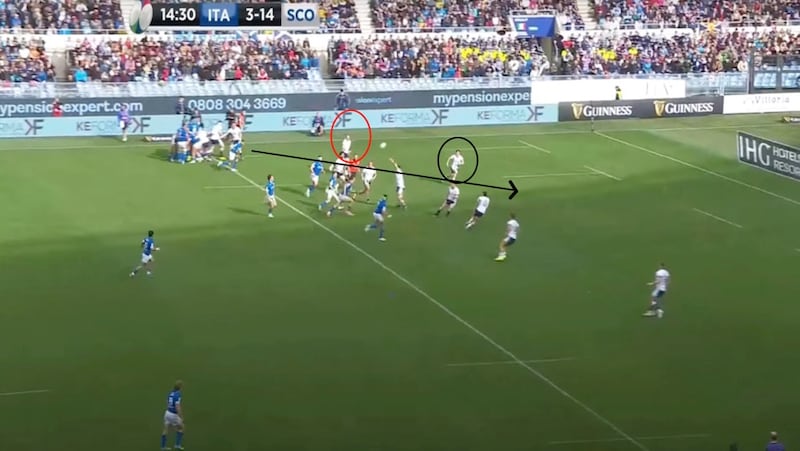
Scotland should learn to avoid allowing their backfield to be manipulated in this way. Their record of giving up kick-tries suggests otherwise.
Restore the power outage
England did many things to shut down Ireland’s much-vaunted attack. Arguably their most effective ploy was to nullify the most prominent Irish forward carriers.
Comparing stats to games against Italy and Wales, two sides that lack the power of an English pack, isn’t a fair reflection, but even against France, the individuals Ireland rely on most for go-forward ball were significantly more effective than at Twickenham.
In Marseille, Caelan Doris carried for 41 metres. Tadhg Beirne came up with 32 metres, Dan Sheehan 22 metres, Joe McCarthy 29 metres in his breakout game. Against England? Doris was held to 16 metres, Sheehan 11 metres, McCarthy 3 metres. Beirne doesn’t register on the list for that stat. Granted, one game was vs 14 men for the majority, but the divergence is too great to put it down to that alone.
In the backs, Bundee Aki actually made more ground against England than France (50m vs 36m), as did James Lowe (51 metres vs 42 metres), a reflection of how they – Aki in particular – carried well through heavy traffic brought by England’s blitz defence.
Part of the carrying issue for Ireland was a lack of space because of the line speed. In the opening stages, Ireland countered the blitz with a narrow pick-and-go game that gained ground and led to a Jack Crowley penalty, only to largely abandon the ploy thereafter.
However, a significant part of the problem was simply being physically outmatched by an England side hitting an emotional fever pitch. That cannot happen again when playing Scotland.

Ireland vs Scotland - Grudge match or rivalry?
Limit transition attacks
Ireland got caught by England transitioning quickly from defence into attack last weekend, Ollie Lawrence and George Furbank both scoring off kick returns. The bad news for Andy Farrell’s side is Scotland have a better recent history of being a dangerous counter-attacking side.
In the Scottish victory over England, Duhan van der Merwe ran in a score from deep directly off an English turnover. Against France, Ben White got on the end of a scintillating break that came directly from Scotland winning the ball back in the air.
With Finn Russell as good as anyone in the game at spotting space, plus a backthree of Van der Merwe, Steyn and Blair Kinghorn, Scotland have a number of threats. Ireland will need to avoid kicking loosely with a disorganised chase – as they did against England – and to minimise errors leading turnovers, particularly when fielding the inevitable flurry of kicks from Russell.
Ireland could eliminate the counter-attacking threat by ensuring all clearances sail into the stands, guaranteeing no kick return. They didn’t consciously keep the ball on the park against England, but poor execution meant this often happened.
However, Scotland’s lineout tends to be a good platform for their creative midfield attack. Against England, Ireland’s first phase defence was passive. Across the board, Ireland’s kick execution, chase and lineout defence must improve.
Take away the tail
Scotland’s record at the set piece is intriguing. They throw to the back of the lineout far more often than any other Six Nations side (28.3 per cent). This suggests confidence in the set piece to take that risk more often than not, and it hasn’t dramatically affected their overall success rate – 87 per cent.
It’s clear to see why they want to go long. If successful, the tail of the lineout offers the best quality ball to their dangerous backline. The other benefit of throwing to the back comes at the maul, given drives starting further from the touchline are harder to defend. Scotland are the joint-best side in the championship for maul-metres made per match (14.3) while they comfortably make the most metres per maul (4.1).

A straightforward tactic for Ireland’s forwards coach Paul O’Connell is to heavily mark up and take away that deep option, forcing Scotland to throw to the front which is easier to defend.
As for the scrum, this has been solid for Scotland without being a weapon. They have won no scrum penalties thus far and are mid-table for conceding penalties.
Expose the midfield
For all their attacking threat, Scotland’s midfield defence is average at best.
Dating back to last year’s World Cup pool stage meeting between these two sides, Ireland carved up the Scottish defence in the 13 channel with their first attack, culminating in a James Lowe score. The same happened for a Hugo Keenan try later in that first half.
When defending from 13 out to the touchline, Scotland send a shooter out of the line. That is not uncommon, but the speed with which he moves is. Instead of flying out of the line to hit an attacker before he gets his pass away, the Scottish shooter often comes up and floats in the general area where he thinks the ball will go.
This floater – as opposed to a South African-style shooter – is disconnected from his defensive line, leaving gaps by positioning himself higher up the pitch than his team-mates. If this player doesn’t shut down the ball, most teams will easily pick him off by sending multiple runners to find the space created by the disconnect.
Scotland adopted this floater approach for both Irish tries listed above. In this year’s Six Nations, France exposed this with a Gael Fickou break, England doing the same for George Furbank’s try at Murrayfield.
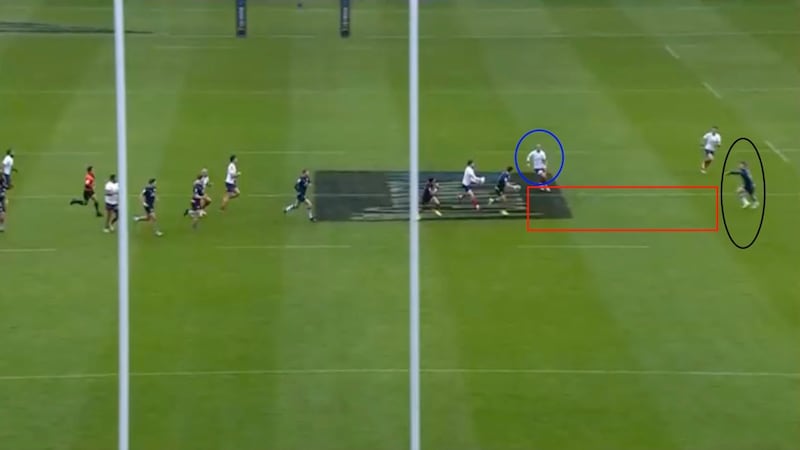
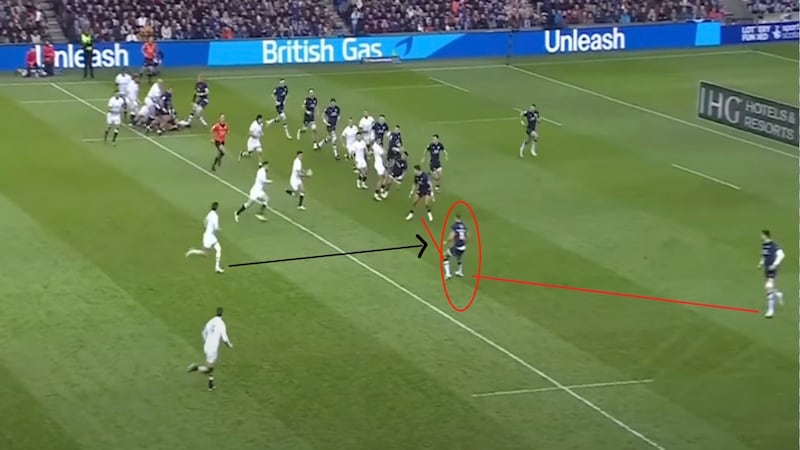
Garry Ringrose started in the 13 channel in that World Cup match for Ireland. Given his excellent handling and decision-making, there is an argument to deploy him at an early enough juncture off the bench against the same opposition given their curious defensive tactics.















